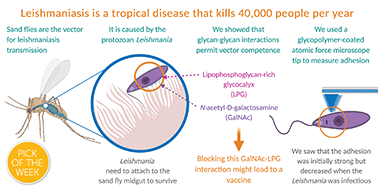Glycan–glycan interactions determine Leishmania attachment to the midgut of permissive sand fly vectors†
Abstract
Direct glycan–glycan interactions are increasingly implicated in survival and pathogenicity of bacteria. Here, we show that they can be exploited by protozoan parasites in their insect hosts. Force spectroscopy revealed that Leishmania promastigotes display a high-affinity biomolecular interaction between their lipophosphoglycan glycocalyx and mimics of N-acetyl-D-galactosamine, commonly expressed on the midguts of a wide range of sand fly vector species. This enabled gut-adhesive nectomonad promastigotes of Leishmania mexicana to efficiently bind to membrane-bound mucin-like, O-linked glycoproteins of the sand fly Lutzomyia longipalpis, an event crucial for parasite survival, and accounts for a permissive mode of binding. Thus, direct interaction between parasite and sand fly midgut glycans are key to permitting vector competence for all forms of leishmaniasis worldwide. In addition, these studies demonstrate the feasibility of interfering with these interactions as transmission-blocking vaccines.

- This article is part of the themed collections: 2020 ChemSci Pick of the Week Collection and 2020 Chemical Science HOT Article Collection


 Please wait while we load your content...
Please wait while we load your content...